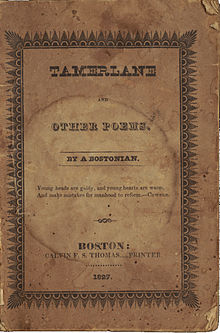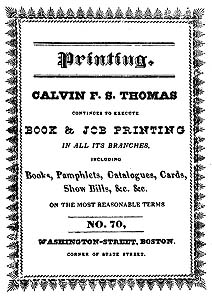Tamerlane and Other Poems

Tamerlane and Other Poems ist das erste veröffentlichte Werk des US-amerikanischen Schriftstellers Edgar Allan Poe. Der nur 40 Seiten umfassende Gedichtband erschien 1827. Soweit bekannt, existieren heute nur noch zwölf Exemplare des Buchs.
Hintergrund
Nach einem Zerwürfnis mit seinem Ziehvater John Allan ging Poe nach Boston, dem Ort seiner Geburt. Ein Grund dafür, dass seine Wahl auf Boston fiel, dürfte gewesen sein, dass ihm seine Mutter Eliza Poe ein von ihr gemaltes Aquarell der Stadt hinterlassen hatte, auf dessen Rückseite stand:
„Für meinen kleinen Sohn Edgar, damit er Boston stets lieb hat – den Ort seiner Geburt – und wo seine Mutter ihre besten und mitfühlendsten Freunde fand. (For my little son Edgar, who should ever love Boston, the place of his birth, and where his mother found her best and most sympathetic friends).“
Veröffentlichungsgeschichte

Im Frühling 1827 übergab Poe sein Manuskript einem erst 18 Jahre alten Drucker namens Calvin F.S. Thomas. Möglicherweise kam der Kontakt zustande, da Poes Eltern mit Thomas’ Eltern bekannt gewesen waren.[1] Thomas druckte ansonsten nur Etiketten und Flugblätter; Tamerlane and Other Poems ist das einzige nachweislich von ihm herausgebrachte Buch. Der Band erschien im Format 17,15 zu 11,43 Zentimeter und kostete zwölfeinhalb Cent. Die Veröffentlichung bezahlte Poe.[2][3][4][5] Als das Buch im Juni oder Juli 1827 erschien, war Poe 18 Jahre alt. Wie viele Exemplare gedruckt wurden, ist ungewiss. Viele Forscher gehen von 50 Exemplaren aus, während andere Zahlen zwischen 20 und 200 angeben.[6]
Tamerlane and Other Poems erschien anonym mit dem Vermerk „Von einem Bostoner“ ("By a Bostonian"). Der Grund hierfür könnte entweder gewesen sein, dass Poe nicht wollte, dass sein Ziehvater seinen Aufenthaltsort herausfand[7], oder aber Poe wollte sich damit bewusst von Richmond distanzieren und sich gleichzeitig Erfolg auf dem wichtigen Bostoner Buchmarkt sichern.[8][9]
Der Gedichtband fand so geringe Verbreitung, dass Rufus Wilmot Griswold ihn 1850 nicht ausfindig machen konnte und behauptete, das Buch sei nie erschienen. Ein erstes Exemplar wurde 1859 wieder aufgefunden, ein zweites 1874.[10]
Thematik

Die Gedichte des Bandes zeigen Einflüsse von Percy Bysshe Shelley, Samuel Taylor Coleridge und vor allem Lord Byron. Tamerlane, Titelfigur des bedeutendsten Gedichts, hat eine Tochter namens Ada, benannt wohl nach Byrons Tochter Ada Lovelace.[9] Poe bewunderte Byrons Lyrik wie auch sein abenteuerliches Leben. Entsprechend machten nach Poes Verschwinden aus Richmond Gerüchte die Runde, er habe sich, wie sein Vorbild Byron, eingeschifft und sich Aufständischen in Griechenland angeschlossen (die Griechische Revolution war seinerzeit allerdings schon Geschichte).[1]
Das Titelgedicht Tamerlane bezieht sich auf die historische Figur des mongolischen Eroberers Tamerlan. Dargestellt wird ein sterbender Herrscher, der bedauert, in seiner Jugend den Ehrgeiz über die Liebe gestellt zu haben. Autobiografische Elemente in dem Gedicht deuten darauf hin, dass Poe den Verlust seiner Jugendliebe Sarah Elmira Royster und/oder seiner Mutter verarbeitet.[11][12] Zudem war Poe, ähnlich wie der Tamerlane des Gedichts, ungewisser Herkunft und trug einen „falschen“ Namen (nämlich Allan).[13]
Für die anderen Gedichte des Bandes gilt, wie Poe selbst eingestand, dass sie:
„ein Wenig zu sehr nach Selbst-Bespiegelung schmecken, doch sind sie von Jemandem geschrieben, der damals noch allzu jung war, als daß er seine Welt-Kenntniß aus anderen Quellen hätte schöpfen können denn aus seinem eigenen Herzen.“
Eines der Gedichte, Imitation, arbeitet Poe später um zu A Dream Within a Dream, und Elemente von Evening Star finden sich wieder in Ulalume.
Rezeption
Tamerlane and Other Poems stieß zur Zeit seiner Veröffentlichung auf keinerlei kritischen Widerhall, weder positiv noch negativ. Erwähnt wurde der Band allein in wenigen Listen von Neuerscheinungen.[15]
Der Literaturwissenschaftler Joseph Wood Krutch nannte den Band in den 1920er Jahren „bis auf wenige Gedichte das Werk eines Anfängers“.[16]
Soweit bekannt existieren nur noch zwölf Exemplare von Tamerlane and Other Poems, womit der Band eine der seltensten Erstausgaben der US-amerikanischen Literatur ist.[17] Die meisten Exemplare befinden sich in den Sammlungen von Bibliotheken und Museen. Im Dezember 2009 wurde ein Original für 662.500 US-Dollar ersteigert.[18]
Inhaltsverzeichnis
Neben einem Vorwort enthält der Band zehn Gedichte in folgender Reihenfolge[19]:
- "Tamerlane"
- "To — —" (bekannt unter dem Titel "Song")
- "Dreams"
- "Visits of the Dead" (bekannt unter dem Titel "Spirits of the Dead")
- "Evening Star"
- "Imitation"
- Gedicht ohne Titel (bekannt unter dem Titel "Stanzas")
- Gedicht ohne Titel (bekannt unter dem Titel "A Dream")
- Gedicht ohne Titel (bekannt unter dem Titel "The Happiest Day")
- "The Lake"
Literatur
- William Bittner: Poe: A Biography. Boston 1962.
- Shelly Costa Bloomfield: The Everything Guide to Edgar Allan Poe: The Life, Times, and Work of a Tormented Genius. New York 2008, ISBN 978-1-59869-527-4.
- Nicholas A. Basbanes: A Gentle Madness: Bibliophiles, Bibliomanes, and the Eternal Passion for Books. New York 1999, ISBN 0-8050-6176-2.
- Joseph Wood Krutch: Edgar Allan Poe: A Study in Genius. New York 1926.
- Harry Lee Poe: Edgar Allan Poe: An Illustrated Companion to His Tell-Tale Stories. New York 2008, ISBN 978-1-4351-0469-3.
- Kenneth Silverman: Edgar A. Poe: Mournful and Never-ending Remembrance. New York u. a. 1991, ISBN 0-06-092331-8.
- Dawn B. Sova: Edgar Allan Poe: A to Z. New York 2001, ISBN 0-8160-4161-X.
Weblinks
- Liste der bekannten Exemplare von Tamerlane and Other Poems. Edgar Allan Poe Society
- 1884 Tamerlane and Other Poems. bei Google Books
Einzelnachweise
- ↑ a b c Kenneth Silverman: Edgar A. Poe: Mournful and Never-Ending Remambrance. New York u. a. 1991, ISBN 0-06-092331-8, S. 38.
- ↑ Irwin Porges: Edgar Allan Poe, New York 1963, S. 64.
- ↑ E.A.Poe: Werke. Band 4, Olten 1966, S. 782.
- ↑ Harry Lee Poe: Edgar Allan Poe: An Illustrated Companion to His Tell-Tale Stories. New York 2008, ISBN 978-1-4351-0469-3, S. 34
- ↑ David Randall, David Anton: Dukedom Large Enough: Reminiscences of a Rare Book Dealer, 1929-1956. New York 1969, S. 186.
- ↑ Shelly Costa Bloomfield: The Everything Guide to Edgar Allan Poe: The Life, Times, and Work of a Tormented Genius. New York 2008, ISBN 978-1-59869-527-4, S. 39.
- ↑ Dawn B. Sova: Edgar Allan Poe: A to Z. New York 2001, ISBN 0-8160-4161-X, S. 253.
- ↑ Kay Cornelius: Biography of Edgar Allan Poe. In: Harold Bloom (Hrsg.): Bloom's BioCritiques: Edgar Allan Poe. Philadelphia 2002, ISBN 0-7910-6173-6.
- ↑ a b Kenneth Silverman: Edgar A. Poe: Mournful and Never-Ending Remambrance. New York u. a. 1991, ISBN 0-06-092331-8, S. 41.
- ↑ Harry Lee Poe: Edgar Allan Poe: An Illustrated Companion to His Tell-Tale Stories. Metro Books, New York 2008, ISBN 978-1-4351-0469-3, S. 34.
- ↑ Daniel Hoffman: Poe Poe Poe Poe Poe Poe Poe. Baton Rouge, 1972, ISBN 0-8071-2321-8, S. 27.
- ↑ Dawn B. Sova: Edgar Allan Poe: A to Z. New York 2001, ISBN 0-8160-4161-X, S. 233.
- ↑ Kenneth Silverman: Edgar A. Poe: Mournful and Never-Ending Remambrance. New York u. a. 1991, ISBN 0-06-092331-8, S. 39.
- ↑ Edgar: Vorrede zur Ausgabe von 1827, übers. von Friedrich Polakovics, E.A. Poe: Werke. Band 4. Olten, 1966, S. 237.
- ↑ Killis Campbell: Contemporary Opinions of Poe. In: The Mind of Poe and Other Studies. New York 1962, S. 373–378.
- ↑ Joseph Wood Krutch: Edgar Allan Poe: A Study in Genius. New York 1926, S. 65.
- ↑ Lloyd Rose: Yo, Poe: In Richmond, A Museum Rises From The Dead. In: Washington Post. 10. Mai 1998.
- ↑ Rare Edgar Allan Poe Book Sets New Auction Record.
- ↑ Tamerlane and Other Poems bei der Edgar Allan Poe Society
| Gedichte | Tamerlane (1827) • Song (1827) • Dreams (1827) • Spirits of the Dead (1827) • Evening Star (1827) • Imitation (1827) • Stanzas (1827) • A Dream (1827) • The Happiest Day (1827) • The Lake (1827) • Sonnet—To Science (1829) • Al Aaraaf (1829) • Romance (1829) • To — — (1829) • To The River — (1829) • To M— (1829) • Fairy-Land (1829) • To Helen (1831) • Israfel (1831) • Die Schlafende (1831) • The Valley of Unrest (1831) • The City in the Sea (1831) • Enigma (1833) • Serenade (1833) • To — (Sleep On) (1833) • Fanny (1833) • The Coliseum (1833) • To One in Paradise (1834) • To Elizabeth (1835) • To Mary (1835) • Bridal Ballad (1837) • To Zante (1837) • The Haunted Palace (1839) • Sonnet — Silence (1840) • Der Erobererwurm (1843) • Lenore (1843) • Dream-Land (1844) • Eulalie (1845) • Der Rabe (1845) • Impromptu. To Kate Carol (1845) • To — (1845) • The Divine Right of Kings (1845) • Stanzas (1845) (1845) • A Valentine (1846) • To M. L. S— (1847) • Ulalume (1847) • To Marie Louise (1848) • An Enigma (1848) • The Bells (1849) • A Dream Within a Dream (1849) • For Annie (1849) • Eldorado (1849) • To my Mother (1849) • Annabel Lee (1849) • O, Tempora! O, Mores! (1868) • Alone (1875) |
| Gedichtbände | Tamerlane and Other Poems (1827) • Al Aaraaf, Tamerlane and Minor Poems (1829) • Poems (1831) • The Raven and Other Poems (1845) |
| Geschichten | Metzengerstein (1832) • The Duc de L’Omelette (1832) • A Tale of Jerusalem (1832) • Loss of Breath (1832) • Bon-Bon (1832) • MS. Found in a Bottle (1833) • Die Verabredung (1834) • Berenice (1835) • Morella (1835) • Lionizing (1835) • The Unparalleled Adventure of One Hans Pfaall (1835) • König Pest (1835) • Shadow – A Parable (1835) • Four Beasts in One – The Homo-Cameleopard (1836) • Mystification (1837) • Silence – A Fable (1837) • Ligeia (1838) • How to Write a Blackwood Article (1838) • A Predicament (1838) • The Devil in the Belfry (1839) • The Man That Was Used Up (1839) • Der Untergang des Hauses Usher (1839) • William Wilson (1839) • The Conversation of Eiros and Charmion (1839) • Why the Little Frenchman Wears His Hand in a Sling (1840) • The Business Man (1840) • Der Mann der Menge (1840) • Der Doppelmord in der Rue Morgue (1841) • A Descent into the Maelström (1841) • The Island of the Fay (1841) • The Colloquy of Monos and Una (1841) • Never Bet the Devil Your Head (1841) • Eleonora (1841) • Drei Sonntage in einer Woche (1841) • Das ovale Porträt (1842) • Die Maske des Roten Todes (1842) • The Landscape Garden (1842) • Das Geheimnis der Marie Rogêt (1842) • Die Grube und das Pendel (1842) • Das verräterische Herz (1843) • Der Goldkäfer (1843) • Der schwarze Kater (1843) • Diddling (1843) • The Spectacles (1844) • A Tale of the Ragged Mountains (1844) • The Premature Burial (1844) • Mesmerische Offenbarung (1844) • Die längliche Kiste (1844) • The Angel of the Odd (1844) • Thou Art the Man (1844) • The Literary Life of Thingum Bob, Esq. (1844) • Der entwendete Brief (1844) • The Thousand-and-Second Tale of Scheherazade (1845) • Some Words with a Mummy (1845) • The Power of Words (1845) • The Imp of the Perverse (1845) • The System of Doctor Tarr and Professor Fether (1845) • Die Tatsachen im Fall Waldemar (1845) • Die Sphinx (1846) • Das Fass Amontillado (1846) • The Domain of Arnheim (1847) • Mellonta Tauta (1849) • Hopp-Frosch (1849) • Von Kempelen and His Discovery (1849) • X-ing a Paragrab (1849) • Landor’s Cottage (1849) |
| Andere Werke | Maelzel’s Chess Player (1836) • The Daguerreotype (1840) • The Philosophy of Furniture (1840) • A Few Words on Secret Writing (1841) • The Rationale of Verse (1843) • Morning on the Wissahiccon (1844) • Old English Poetry (1845) • Die Philosophie der Komposition (1846) • Das poetische Prinzip (1846) • Heureka (1848) • The Balloon-Hoax (1844) • The Narrative of Arthur Gordon Pym of Nantucket (1838) • Das Tagebuch des Julius Rodman (1840) • Politian (1835) • The Conchologist’s First Book (1839) • Der Leuchtturm (1849) |











